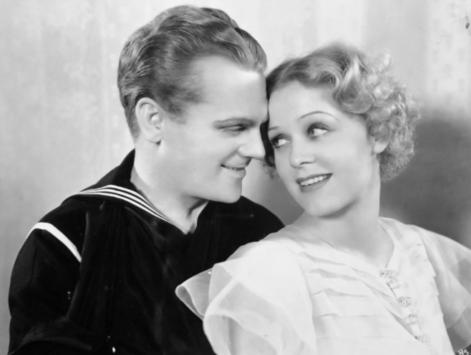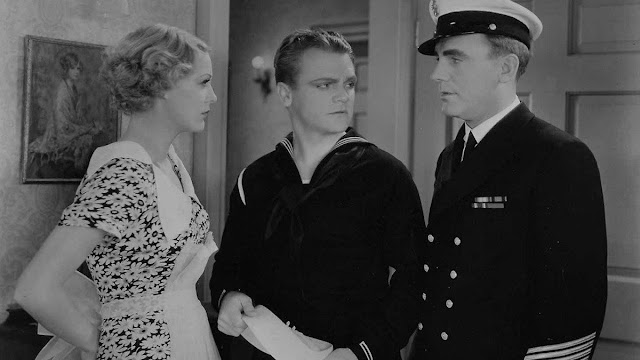Almost two years ago to the day my wife and I took a much needed vacation to O’ahu, Hawai’i. One of the main reasons we chose this island over more tranquil ones like Maui or the Big Island was so that we could tour Pearl Harbor and visit the USS Arizona monument. Our tour was awe-inspiring and humbling as we stood on the monument and looked down into the Pacific Ocean at the wreckage of that once proud military vessel felled in a surprise attack by the Japanese during World War II. So many soldiers died that day and many of their bodies are still down there in that wreckage. More still have been transplanted there in the years since, buried alongside their comrades. I speak of this experience because as I began watching 1934’s Here Comes the Navy I was surprised and moved to discover that not only does the USS Arizona factor heavily into the plot, it served as one of the film’s sets and many of the naval extras were actual sailors on that ship. I don’t know if it is anything that can be figured out but I wondered if any of these sailors were still serving on the Arizona when it went down in Pearl Harbor. Also of note is that there are shots of the dirigible USS Macon used, filmed a year before the accident that destroyed that airship along with the loss of two crew members. Thinking about these things definitely colored my experience at least a little as I watched what is basically a light-hearted naval comedy/romance set and filmed several years before the second world war exploded on the scene.
The film opens with a conflict arising between riveter Chesty O’Connor (James Cagney) and Chief Petty Officer Biff Martin (Pat O’Brien). This starts out as some taunting and gets elevated to an all out brawl during a formal dance when Biff repeatedly cuts in on Chesty’s dance partner. Biff gets the best of Chesty in the brawl and goes on to win a Waltz trophy with Chesty’s date, leaving the man sore and determined to get even. But Biff is shipping out on the USS Arizona and will soon be out of reach. Not thinking things through, Chesty enlists in the navy thinking he can get quickly on board, exact his revenge, then resign and return to his civilian life. This of course doesn’t work out as he didn’t count on ninety days of basic training and no choice of where he will be stationed afterwards. As soon as he learns this he tries to immediately resign only to be clued in on the reality of the situation. He is now enlisted in the navy.
After basic training he is indeed assigned to the USS Arizona where he makes it clear he has a beef to settle with Biff. But Biff informs him that he is his superior officer and any such brawling will not be tolerated on board ship. While ashore on leave Chesty meets an attractive young woman named Dorothy (Gloria Stuart) and eventually manages to convince her to go out with him, unaware that she is Biff’s sister. This leads to more tension between the two men as Biff tries to convince Gloria that Chesty is no good while she defends him. When Chesty tries to take another leave to go see her, Biff denies the leave prompting Chesty to go AWOL to see her anyway. He gets busted trying to get back on board and is court martial’d. During gunnery practice a fire breaks out in the gun room and Chesty risks his life putting it out with his body, saving the men and equipment, earning himself a medal that he doesn’t want or care about. Sensing his dislike for being at sea he is reassigned to the rigid airship USS Macon instead where, through a series of unlikely events, he is put in a position to save Biff’s life a second time.
1934 was during that brief period of time between the two World Wars. It was still five years before Hitler invaded Poland and sparked the bloodiest war the world had ever known. The great depression was in full swing marking a ten year period of extreme economic decline. A career in the military at this time would have seemed like a wonderful opportunity for people who were struggling through the depression. Those brass young men in their crisp white uniforms manning their stations on board a large military vessel like the Arizona would have been a tempting proposition in 1934, a full five years into the depression. To see a military career treated with such disdain by the lead actor in a major motion picture would have been disheartening. That he never changes his mind about the career makes that even worse. This is not a film about character growth. Chesty doesn’t care about the navy when he joins up and he doesn’t care about it in the end either. He wins a medal for bravery and callously gives it to his friend Droopy (Frank McHugh) claiming he only did what he did to save his own hide. His act of heroism in the final act seems to fly in the face of that attitude but not his overall attitude about the navy and his position in it.
James Cagney was still a relative newcomer to the screen when he appeared in this picture. While his relative callowness is evident so too is his charisma. He has a magnetism that instantly draws our eye to his character even when he isn’t the center of attention. Unfortunately, the character he is given to play is so unlikable that it is hard to get on his side even as we are drawn to pay attention to his every action. It is simply unforgivable that this character never grows more sympathetic as the story plays out. The film ends on a wedding between Chesty and Gloria with Biff begrudgingly giving his sister away. The two men still hate each other and almost come to blows during the ceremony. Chesty, for his act of heroism saving Biff’s life a second time, has been granted a promotion that makes him Biff’s superior officer. Instead of being proud of this honor, he smirks and makes a snide comment about how Biff can no longer give him orders. This scene would be almost unwatchable were it not for the two men being so battered from Chesty’s heroic act that one is in a wheelchair and the other is on crutches.
Pat O’Brien is much too stiff of an actor to be very effective in this part. On the one side it can be argued that being rigid and stone-faced is the way a military officer should be but that doesn’t make for a compelling antagonist. I have not seen every performance O’Brien has given but the ones I have seen all seem like this and it makes me wonder if he has much range beyond officers, policemen and priests. I’m sure he must have but if that is the case I have yet to come across it. This performance is just too one note and uninteresting, automatically forcing our loyalties towards Chesty even though he is an unlikable character, too. By doing this it leaves me conflicted, being asked to root for one or the other when I don’t like either one. Gloria Stuart has the unenviable task of being placed between them but is never given enough screen time to do much with it.
The final action set piece on board the Macon further reflects just how broken this whole film feels. On the one hand it is shot beautifully and the rescue mission is well staged for the time. On the other hand, though, the circumstances that lead to the rescue being necessary in the first place are so convoluted that it ruins the whole moment. Chesty’s actions to save Biff in that moment may be heroic but are in direct conflict with a direct order. It is inconceivable that he would be celebrated so heavily by his superiors for disobeying that direct order, let alone promoted the way that he is.
This film seems like it is confused as to what message it is trying to get across. It is the type of film that would not have been made a few years later when the war was in full swing and studios were churning out pro-war propaganda films. It isn’t an anti-war film by any means but it is not painting the service in a very good light, either. That, coupled with some poorly written characters and plot contrivances make this one of the weaker films to ever get an Academy Award nomination for best picture. Watching it now, ninety years later, it is only really worth it to see Cagney build his on-screen persona and to see the USS Arizona and the Macon when they were still in active service. For that alone the time spent watching Here Comes the Navy is worth it. But those great lost vessels deserved a better film than the one they got.
Academy Award Nominations:
Outstanding Production: Lou Edelman
____________________________________________________
Release Date: July 21, 1934
Running Time: 87 Minutes
Not Rated
Starring: James Cagney, Pat O’Brien and Gloria Stuart
Directed By: Lloyd Bacon








Comments
Post a Comment